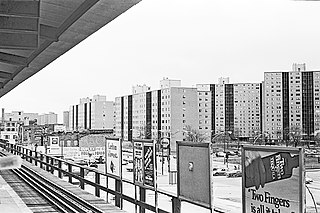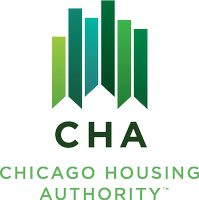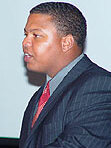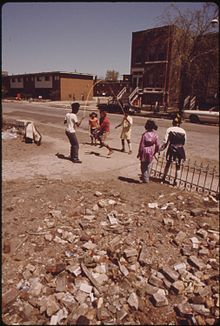
Woodlawn is a neighborhood on the South Side of Chicago, Illinois, located on and near the shore of Lake Michigan 8.5 miles (13.7 km) south of the Loop. It is one of the city's 77 municipally recognized community areas. It is bounded by the lake to the east, 60th Street to the north, King Drive to the west, and 67th Street to the south, save for a small tract that lies south of 67th Street between Cottage Grove Avenue and South Chicago Avenue. Local sources sometimes divide the neighborhood along Cottage Grove into "East" and "West Woodlawn."

Cabrini–Green Homes are a Chicago Housing Authority (CHA) public housing project on the Near North Side of Chicago, Illinois. The Frances Cabrini Rowhouses and Extensions were south of Division Street, bordered by Larrabee Street to the west, Orleans Street to the east and Chicago Avenue to the south, with the William Green Homes to the northwest.

Robert Taylor Homes was a public housing project in the Bronzeville neighborhood on the South Side of Chicago, Illinois from 1962 to 2007. The second largest housing project in the United States, it consisted of 28 virtually identical high-rises, set out in a linear plan for two miles, with the high-rises regularly configured in a horseshoe shape of three in each block. It was located along State Street between Pershing Road and 54th Street, east of the Dan Ryan Expressway. The project was named for Robert Rochon Taylor (1899–1957), an African-American activist and the first African American chairman of the Chicago Housing Authority (CHA). It was a part of the State Street Corridor which included other CHA housing projects: Stateway Gardens, Dearborn Homes, Harold Ickes Homes, and Hilliard Homes.

Douglas, on the South Side of Chicago, Illinois, is one of Chicago's 77 community areas. The neighborhood is named for Stephen A. Douglas, Illinois politician and Abraham Lincoln's political foe, whose estate included a tract of land given to the federal government. This tract later was developed for use as the Civil War Union training and prison camp, Camp Douglas, located in what is now the eastern portion of the Douglas neighborhood. Douglas gave that part of his estate at Cottage Grove and 35th to the Old University of Chicago. The Chicago 2016 Olympic bid planned for the Olympic Village to be constructed on a 37-acre (15 ha) truck parking lot, south of McCormick Place, that is mostly in the Douglas community area and partly in the Near South Side.

Oakland, located on the South Side of Chicago, Illinois, USA, is one of 77 officially designated Chicago community areas. Bordered by 35th and 43rd Streets, Cottage Grove Avenue and Lake Shore Drive, The Oakland area was constructed between 1872 and 1905. Some of Chicago's great old homes may be seen on Drexel Boulevard. The late 19th-century Monument Baptist Church on Oakwood Blvd. is modeled after Boston's Trinity Church. Oakwood/41st Street Beach in Burnham Park is at 4100 S. Lake Shore Drive. With an area of only 0.6 sq mi Oakland is the smallest community area by area in Chicago.

The history of African Americans in Chicago or Black Chicagoans dates back to Jean Baptiste Point du Sable's trading activities in the 1780s. Du Sable, the city's founder, was Haitian of African and French descent. Fugitive slaves and freedmen established the city's first Black community in the 1840s. By the late 19th century, the first Black person had been elected to office.

Stateway Gardens was a Chicago Housing Authority (CHA) public housing project in the Bronzeville neighborhood on the South Side of Chicago, Illinois, alongside the Dan Ryan Expressway just north of the former Robert Taylor Homes, and part of the State Street Corridor that also included Dearborn Homes, Harold Ickes Homes and Hillard Homes. Stateway Gardens consisted of mid- and high-rise apartment buildings.

Ghetto Life 101 is a 30-minute radio broadcast documentary exploring the lives of residents of the South Side of Chicago, Illinois. It was created by teenagers LeAlan Jones and Lloyd Newman and produced by David Isay for National Public Radio. The broadcast garnered international acclaim and won several awards.

The Chicago Housing Authority (CHA) is a municipal corporation that oversees public housing within the city of Chicago. The agency's Board of Commissioners is appointed by the city's mayor, and has a budget independent from that of the city of Chicago. CHA is the largest rental landlord in Chicago, with more than 50,000 households. CHA owns over 21,000 apartments. It also oversees the administration of 37,000 Section 8 vouchers. The current acting CEO of the Chicago Housing Authority is Tracey Scott.

The Chicago Housing Authority Police Department (also known as the CHAPD) was created as a supplement to the Chicago Police Department (CPD), to provide dedicated police services to the residents of one of the nation's most impoverished and crime ridden developments for low-income housing. The CHAPD accomplished their daily goals by utilizing "community oriented policing techniques and aggressive vertical patrol" of all Chicago Housing Authority public housing projects throughout the inner city of Chicago, Illinois and some suburban areas.

The South Side is one of the three major sections of the city of Chicago, Illinois, United States. Geographically, it is the largest of the three sections of the city, with the other two being the North and West Sides. It radiates and lies south of the city's downtown area, the Chicago Loop.
James "Jim" R. Martin is an American writer, independent producer, director, and documentary filmmaker. He is best known for his PBS feature-length documentary Wrapped In Steel, broadcast nationally in 1984–85, and PBS documentary Fired-Up Public Housing is my Home broadcast nationally in 1988–89. Both Wrapped In Steel and Fired-Up were nominated for Emmy. Fired-Up won an Emmy for Best Independent Network Documentary, Chicago. Author, Create Documentary Films, Videos, And Multimedia: a comprehensive guide to using documentary storytelling techniques for film, video, Internet and digital media projects. ISBN 978-0-9827023-0-7, Actuality Interviewing and Listening 2017 ISBN 978-0-9827023-6-9, Documentary Directing and Storytelling 2018 ISBN 978-1-7216794-6-1, Listen Learn Share 2018 ISBN 978-0-9827023-8-3,Storytelling In The SEO Age 2023 ISBN 979-8-9875933-87, Office and Home Tai Chi with Yue Zhang 2020 ISBN 979-8-9875933-5-6, The Shaolin Temple Story with Shi Yongxin 2023 ISBN 979-8-9855287-4-9, Silhouettes and Shadows 2022 ISBN 979-8-9855287-2-5

Henry Horner Homes was a Chicago Housing Authority (CHA) public housing project located in the Near West Side community area on the West Side of Chicago, Illinois, United States. The original section of Henry Horner Homes was bordered by Oakley Boulevard to the west, Washington Boulevard to the south, Hermitage Avenue to the east, and Lake Street to the north near the United Center. A discontiguous section named Horner Annex was bordered by Honore Street to the west, Adams Street to the south, Wood Street to the east, and Monroe Street to the north. Constructed between 1957 and 1963, The housing project was named in honor of former Illinois governor Henry Horner.

LeAlan Marvin Jones is an American journalist who lives in Chicago's South Shore. His radio documentaries have received critical acclaim and numerous awards. Jones was the Green Party's 2010 nominee for United States Senate from Illinois.
The Airport Homes race riots were a series of riots in 1946 in the West Lawn and West Elsdon neighborhoods of Chicago, Illinois. It was the worst episode of racial inspired violence that the city faced in some thirty years.

Dearborn Homes is a Chicago Housing Authority (CHA) public housing project located in the Bronzeville neighborhood on the South Side of Chicago, Illinois. It is located along State Street between 27th and 30th Streets, and bounded by the Metrarail line to the west. It is one of only two housing projects that still exist from the State Street Corridor which included other CHA developments: Robert Taylor Homes, Stateway Gardens, Harold Ickes Homes and Hillard Homes.
Eric Morse was a five-year-old African-American boy from Chicago, Illinois, who was murdered in October 1994. Morse was dropped from a high-rise building in the Ida B. Wells Homes by ten-year-old Jesse Rankins and 11-year-old Tykeece Johnson. Morse's murder was notable for the young ages of the victim and the killers, and brought further national attention to the plight of children in Chicago's housing projects. Rankins and Johnson, both minors at the time, were convicted for the murder of Morse and sentenced to five years' imprisonment each.

The Lake Michigan High-Rises, also known as Lakefront Homes, was a Chicago Housing Authority (CHA) public housing project in the North Kenwood–Oakland neighborhood located in the South Side of Chicago, Illinois, United States. Constructed in 1962 and completed in 1963, The Lake Michigan High-Rises originally consisted of four 16–story buildings; totaling 457 units. The Lake Michigan High-Rises was located west of Lake Shore Drive and was included as a part of the CHA Lakefront Properties. Today, only two buildings of the Lakefront Properties exist; they were officially renamed from Victor Olander Homes to Lake Parc Place in 1991. The other four high–rises were demolished by implosion in December 1998, it was the first and only to date in Chicago Housing Authority history.

Wentworth Gardens is a 344-unit housing project operated by the Chicago Housing Authority (CHA). It lies just south of Guaranteed Rate Field in Bronzeville on Chicago's south side.

TheLight of Truth Ida B. Wells National Monument is a bronze and marble public sculpture by artist Richard Hunt. Located in the Bronzeville neighborhood on the South Side of Chicago, the sculpture takes its name from a quote by civil rights activist and investigative journalist Ida B. Wells-Barnett (1862-1931): "The way to right wrongs is to turn the light of truth upon them". It was unveiled in 2021 by the Ida B. Wells Commemorative Art Committee.






















